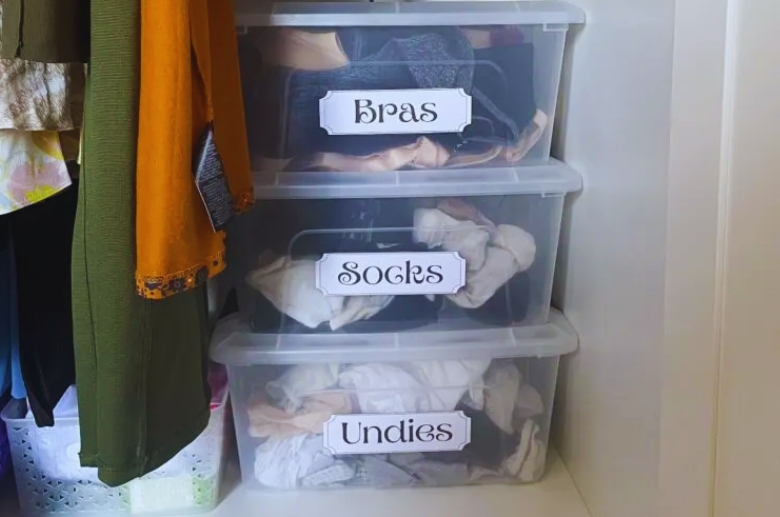Connect With A Garage Expert
Connect with local experts, Compare quotes, Get the best price.
Are you constantly battling with the never-ending challenge of managing your ever-expanding wardrobe? Do you find your closet is overflowing to its limits, leaving you with that “I have nothing to wear” feeling each morning? If so, you’re certainly not alone in your struggle.
In this guide, we’ll show you how to store clothing in the garage, offering a practical and space-saving solution to declutter your living spaces while keeping your wardrobe organized and accessible. Say farewell to the chaos and hello to an orderly, accessible closet with our expert guidance.
Can You Store Clothes in the Garage?

Your garage can serve as a practical and versatile space for clothing storage. Whether you’re looking to free up room in your closet, create a seasonal clothing storage solution, or simply need extra space for your extensive wardrobe, the garage offers a cost-effective and accessible option.
Storing clothes in the garage can work well if done correctly. One key factor is climate control. Since garages tend to experience more significant temperature swings than inside the home, take steps to protect the clothes. Consider installing insulation and temperature regulation devices. Dehumidifiers can also help prevent mold and mildew from developing on the fabrics.
Another aspect is accessibility and convenience. Designate specific shelving units or storage bins for the garage clothes. Categorize items by season or type. Add lighting so you can easily see inside the containers. Having organized systems will make it fast and simple to retrieve items when needed. Regularly go through the clothes to weed out no longer worn pieces.
Why Should You Store Your Clothes in the Garage?
Garage clothing storage offers practicality and space-saving solutions. Here are a few reasons for this convenient storage method.
Improve Space
Storing your clothing in the garage is a practical solution to free up room inside your home. To ensure you’re making the most of this extra space, consider implementing a few tactics:

- Wall-Mounted Shelves: Install sturdy wall-mounted shelves in your garage to expand closet space. These shelves can hold storage containers or boxes, helping you organize your clothing. Utilize clear plastic bins or labeled boxes to make it easy to find specific items.
- Garment Racks: For clothing items you use frequently, set up garment racks in your garage. These racks are perfect for hanging coats, sweaters, jackets, or often-worn garments. By doing this, you create a mini closet in your garage, making it easier to access these items without cluttering your bedroom or hallway.
- Utilize Vertical Space: Make the most of the vertical space in your garage. Consider installing hooks or pegboards on the walls to hang accessories like scarves, belts, or hats. This not only keeps them organized but also prevents them from getting tangled or lost.
- Seasonal Rotation: Given the garage’s additional storage capacity, you can implement a seasonal rotation system. For instance, during the winter, store your summer clothing, and vice versa. This not only saves space in your closets but also helps you stay organized and efficiently manage your wardrobe.
Safely Conserves the Quality of Fabric
When it comes to storing clothing in your garage, you’re not just gaining extra space; you’re also providing a controlled environment that can work wonders for the longevity and quality of your garments. Here are some ways to ensure your clothes remain in top-notch condition:
- Garment Bags: For more delicate or unique occasion garments, garment bags are an excellent choice. They provide an added layer of protection against dust and potential snags. Opt for breathable garment bags to prevent moisture buildup inside. Use garment bags and hangers to safeguard your elegant evening gowns, suits, or wedding attire, maintaining their pristine appearance.
- Moisture Control: Maintaining humidity levels in your garage is crucial to prevent mold and mildew from affecting your clothing. Place moisture absorbers or dehumidifiers in your garage storage area to ensure a dry environment. These simple devices can go a long way in preserving the integrity of your fabrics.
Using moisture absorbers, you can protect your leather jackets or suede shoes from the potential damage caused by excessive humidity.
Effective Approach Due to Seasonal Changes
Utilizing your garage for clothing storage is particularly efficient when it comes to managing seasonal wardrobes. To establish an effective system, follow these steps:

- Categorizing Clothing by Season: To effectively manage seasonal clothing storage in your garage, start by sorting your clothes or bag into categories based on the seasons, including summer, fall, winter, and spring. This initial step simplifies finding and accessing the right clothes when needed.
- Using Clear Labeled Containers: Invest in clear plastic containers with secure lids for each clothing category. These containers should be transparent, allowing you to see the contents inside easily. To further enhance organization, label each container clearly. This labeling system quickly identifies what’s stored in each container, making retrieval a breeze.
- Ensuring Accessibility for Current Season Items: It’s crucial to keep clothing readily accessible for the current season. Store these items in containers or lower shelves that are easy to reach. Doing this will minimize the hassle of searching for and retrieving your day-to-day outfits, ensuring a smooth start to your day.
Connect With A Garage Expert
Connect with local experts, Compare quotes, Get the best price.
Things to Consider Before Storing Your Clothes in the Garage
Before transforming your garage into a clothing storage space, there are some essential factors to remember.
1. Double-Check for Pests
Before storing your clothes, thoroughly inspect the garage for signs of pests or any signs of insect bugs such as Silverfish. Why is this step necessary? Well, pests can wreak havoc on your wardrobe, causing damage that ranges from unsightly holes to irreversible fabric deterioration.
Moths, in particular, pose a significant threat as they have a notorious appetite for clothing fibers, literally feasting on fabric. The larvae of moths are exceedingly voracious, consuming natural fibers like wool, silk, and cotton.
Here are some steps to eliminate and keep your garage free from any pests.
- Seal Cracks and Openings: To prevent pests from entering the garage, seal any cracks, gaps, or openings in the walls, doors, and windows. This creates a barrier against their entry, keeping your clothing safe.
- Use Pest Control Methods: If you discover an existing pest issue, consider using appropriate pest control methods. This may involve setting traps or hiring professional pest control services to address the problem effectively.
- Install Protective Barriers: Take preventive measures by installing protective barriers such as door sweeps and window screens. These barriers block potential entry points for pests, creating an extra layer of defense.
- Maintain a Clean Environment: Keep your garage clean and free of food debris or items that may attract pests, such as the smell of the food. Regularly remove trash and clutter to deter unwanted visitors.
2. Avoid Heat
Shielding your clothing from extreme heat is crucial to ensuring its long-term durability. Excessive heat can damage fabrics and cause them to shrink, warp, discolor, or lose their shape.
Ideal storage temperatures for most fabrics like cotton, wool, silk, and linen are between 60-75°F. Temperatures above 90°F can start to impact clothing over time negatively. More delicate fabrics like silk and linen are prone to damage at even lower temperatures above 80°F.

Here are some steps to protect your garments in your garage:
- Adequate Ventilation: Ensure your residential garage is well-ventilated to prevent heat buildup. Installing vents or windows can help in this regard. Proper airflow prevents stagnant, hot air that can damage your clothing. For example, during the summer, if your garage has good ventilation, it prevents your leather jackets from drying out and your delicate fabrics from fading due to excessive heat.
- Insulation: If possible, insulate your garage to control temperature fluctuations. This step helps maintain a more stable and moderate climate within the space. Insulation can be beneficial in regions with harsh weather conditions. The ideal temperature to keep in a garage is between 55°F and 80°F. In cold winter, insulation in your garage can prevent your clothing from being exposed to freezing temperatures, which could harm the fabric and lead to cracks in leather items.
3. Keep Away from Light
Prolonged exposure to direct sunlight or artificial light can cause colors to fade. Here are some practical tips for protecting your clothes from fading while stored in the garage.
- Wrap clothing items individually in acid-free tissue paper inside containers and boxes. This creates additional light barriers around each garment. Acid-free tissue avoids discoloration from acidic paper degradation.
- Arrange containers away from windows, garage doors, and other light sources. Face openings away from lights, stack more oversized items on tops of bins to shade shorter boxes and utilize shadows in corners furthest from entryways or bulb locations.
- Hang longer clothing like dresses and coats in garment bags made of canvas, quilted materials, or light-blocking plastics. Ensure bags overlap openings fully and remain zipped or clasped shut. Again, position away from light sources.
Choose the Appropriate Container or Wardrobe
When it comes to selecting the proper storage solution for your clothing, it’s essential to make an informed choice. Here’s how to go about it:
- Consider Your Needs: Assess your specific storage requirements. Are you looking to store seasonal clothing such as winter coats, clothes with fur, sports equipment, or everyday attire? Understanding your needs will guide you in choosing the most suitable storage solution.
- Explore Options: There are various storage solutions available, so explore your options. Garment racks offer a convenient open storage option, allowing easy access to your daily wear. Wardrobe closets provide a closed and dust-free space for your clothing. Each option has advantages, so select the one that aligns with your needs.
- Prioritize Cleanliness: Before placing your clothing inside the chosen container or wardrobe, ensure that it’s clean and dry. Cleaning the storage space minimizes the risk of dirt or moisture affecting your dresses. A clean environment will help preserve your clothes in good condition.
Properly Sort Out the Clothes First
Before storing, go through your clothing to identify items for donation, repair, or disposal. This minimizes the volume of clothing you need to store and ensures that only the garments you intend to keep are placed in the garage. Organize the clothes by season or type for easier retrieval.
Connect With A Garage Expert
Connect with local experts, Compare quotes, Get the best price.
5 Ways on How to Store Clothing in the Garage
Discovering effective ways to store clothing in the garage can be a game-changer for maximizing space and maintaining organization. Whether you’re dealing with seasonal items, sports gear, or overflow from your closet, these creative solutions will help you optimize your garage space while keeping your wardrobe in top-notch condition.
Step 1: Evaluate Your Garage Space
Before you dive into storing your clothes in the garage, take a good look around and assess your available space. Check for any signs of water leaks, excessive humidity, or extreme temperature fluctuations. If your garage has these issues, consider addressing them, such as sealing cracks and insulating the space.
Step 2: Sort and Declutter
Begin by going through your clothing items and sorting them. Decide what you want to store in the garage and what you may want to keep indoors. Be sure to donate or discard any clothing you no longer need. This not only saves space but also ensures that you’re storing only what’s necessary.
Step 3: Donate Unneeded Clothes to Free Up Space
Donating unneeded clothes to places like Goodwill is an effective and generous way to create additional space in your garage. By parting with clothing items you no longer require, you can declutter your garage while also offering assistance to those in need, achieving a win-win outcome for both your storage needs and the wider community.
Another option is to sell them at a nearby thrift store or online, or garage sale can also be a great way to sell clothes, but the most effective way to part with your old clothes is by donating them to a charity.
Step 4: Use Desiccants and Fragrance Sachets
To maintain a fresh and dry environment for your stored clothing, consider adding desiccant packets or moisture absorbers inside the storage containers. This helps prevent moisture-related damage. Additionally, fragrance sachets, mothballs, or cedar blocks can keep your clothing smelling pleasant and deter pests.
Step 5: Organize and Store Wisely
To make the most of your clothing storage in the garage, it’s crucial to organize and store your items efficiently. Follow these tips to ensure your garments remain in good condition:
- Arrange Systematically: Place your clothing containers in an organized manner within the garage—group similar items together for easy access and better visibility.
- Elevate Containers: Keep the containers off the garage floor to prevent moisture seepage. Use sturdy shelves or racks to elevate them. This precaution safeguards your clothes from potential water damage.
- Weight Distribution: When stacking containers, ensure that heavier ones are placed at the bottom. This prevents damage to lighter containers and makes it easier to access items you might need more frequently.
- Allow for Air Circulation: Maintain adequate space between the containers to facilitate air circulation. This helps minimize moisture buildup and keeps your clothing fresh and dry.
Final Thoughts
Storing clothing in your garage effectively manages overflowing wardrobes and creates home space by thoughtfully organizing garments using clear bins, elevation, ventilation, and strategic placement. Regular upkeep, including inspections for insects like moths, rotating seasonal items, and safeguarding delicate fabrics, ensures your clothing stays accessible and well-protected.
With strategic planning, your garage can be transformed into an optimal climate-controlled storage solution for your expansive wardrobe. Implementing these thoughtful measures ensures that your garage becomes a spacious extension of your closet and a controlled environment that preserves the condition of your clothing, making each item readily accessible.
Transform your garage into a well-organized wardrobe solution today! Get a free consultation now!




